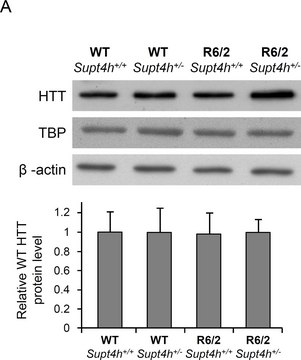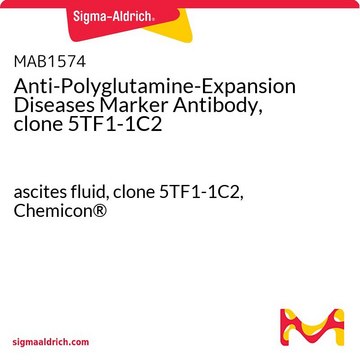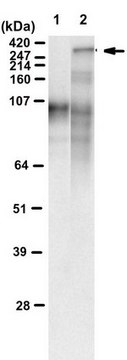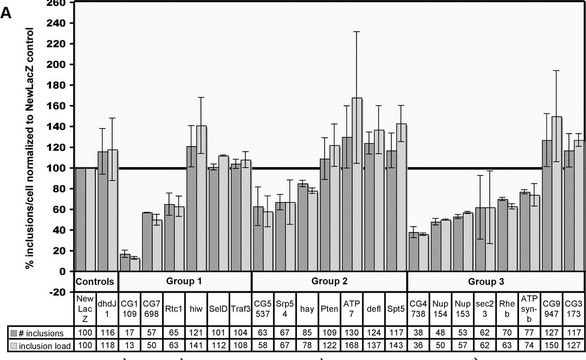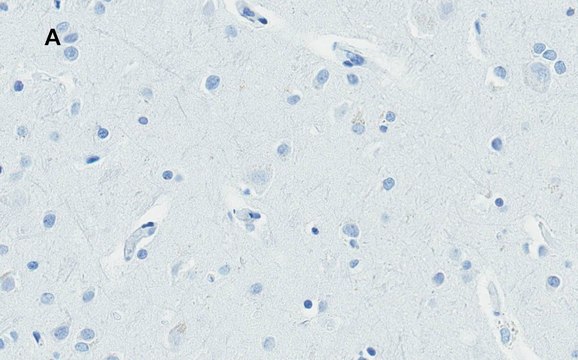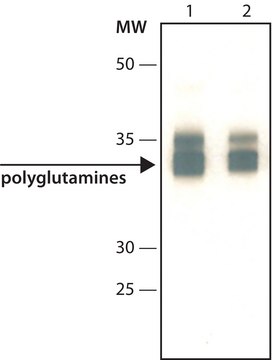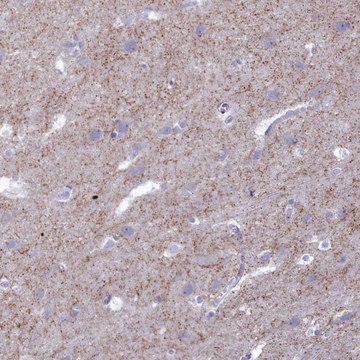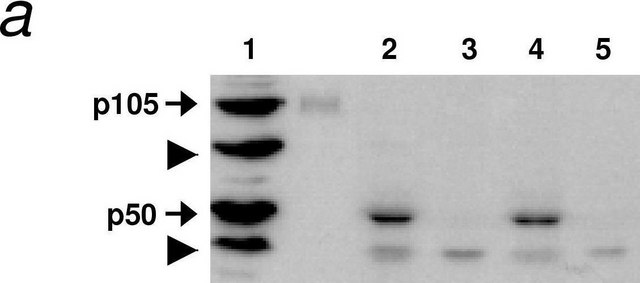推荐产品
产品名称
Anti-Huntingtin Antibody, a.a. 115-129 Antibody, clone 5HU-1H6,
生物来源
mouse
质量水平
偶联物
unconjugated
抗体形式
purified antibody
抗体产品类型
primary antibodies
克隆
5HU-1H6, monoclonal
分子量
calculated mol wt 347.6 kDa
observed mol wt ~350 kDa
种属反应性
human
包装
antibody small pack of 100 μg
技术
immunocytochemistry: suitable
immunofluorescence: suitable
immunohistochemistry (formalin-fixed, paraffin-embedded sections): suitable
western blot: suitable
同位素/亚型
IgG1κ
表位序列
N-terminus
Protein ID登记号
UniProt登记号
运输
dry ice
靶向翻译后修饰
unmodified
基因信息
human ... HTT(3064)
一般描述
Huntingtin (UniProt: P42858; also known as Huntington disease protein, HD protein) is encoded by the HTT (also known as HD, IT15) gene (Gene ID: 3064) in human. This protein is found in the perinuclear region along with microtubules, and in the centrosomal region along with g-tubulin. It is expressed in the brain and is mainly found in the cerebellar cortex, the neocortex, the striatum, and the hippocampal formation. It plays a role in microtubule-mediated transport or vesicle function and shown to be necessary for neuronal survival. It is involved in synaptic vesicle trafficking, and microtubule binding. It contains a nuclear export signal (aa 2395-2404) and 5 HEAT (Huntington, Elongation Factor 3, PR65/A, TOR) domains. It can undergo cleavage by caspases downstream of the polyglutamine stretch and the resulting N-terminal fragments displays cytotoxicity and provokes apoptosis. In response to DNA damage, it undergoes phosphorylation at Serine 1179 and 1199 by CDK5 that is shown to protect neurons against polyglutamine expansion as well as DNA damage mediated toxicity. The N-terminal fragments of mutant huntingtin (mHTT) misfold and assemble into oligomers that ultimately bundle into insoluble fibrils. Misfolding and self-aggregation of specific proteins is commonly observed in well-known neurodegenerative diseases, including Huntington s disease (HD), Alzheimer s disease (AD), Parkinson s disease (PD), and amyotrophic lateral sclerosis (AML). Abnormal polyglutamine (polyQ) repeat sequence or stretch result in protein misfolding and neurodegeneration.
特异性
Clone 5HU-1H6 is a mouse monoclonal antibody that detects human Huntingtin protein. It targets an epitope within 15 amino acids from the N-terminal region.
免疫原
GST-tagged recombinant fragment corresponding to the first 165 amino acids from the N-terminal region of human Huntingtin protein.
应用
Quality Control Testing
Evaluated by Western Blotting in lysates from HEK293 cells transiently overexpressing Huntingtin protein.
Western Blotting Analysis (WB): A 1:250 dilution of this antibody detected Huntingtin in lysates from HEK293 cells transiently overexpressing Huntingtin protein.
Tested Applications
Western Blotting Analysis: A representative lot detected Huntingtin protein in Western Blotting application. (Miller, J.P., et al. (2010). Neuron. 67(2):199-212; Lunke, A. et al. (2002). Mol Cell. 10(2):259-69; Ratovitski, T., et al. (2007). Cell Cycle. 6(23):2970-81; Michels Thompson, L., et al. (2009). J Cell Biol. 187(7):1083-99; Juenemann, K., et al. (2011). Neurotox Res.;20(2):120-33).
Immunohistochemistry Applications: A representative lot detected Huntingtin protein in Immunohistochemistry application. (Lunke, A. et al. (2002). Mol Cell. 10(2):259-69).
Immunofluorescence Analysis: A representative lot detected Huntingtin protein in Immunofluorescence application. (Juenemann, K., et al. (2011). Neurotox Res.;20(2):120-33).
Immunocytochemistry Analysis: A representative lot detected Huntingtin protein in Immunocytochemistry application. (Miller, J.P., et al. (2010). Neuron. 67(2):199-212; Lunke, A. et al. (2002). Mol Cell. 10(2):259-69).
Note: Actual optimal working dilutions must be determined by end user as specimens, and experimental conditions may vary with the end user
Evaluated by Western Blotting in lysates from HEK293 cells transiently overexpressing Huntingtin protein.
Western Blotting Analysis (WB): A 1:250 dilution of this antibody detected Huntingtin in lysates from HEK293 cells transiently overexpressing Huntingtin protein.
Tested Applications
Western Blotting Analysis: A representative lot detected Huntingtin protein in Western Blotting application. (Miller, J.P., et al. (2010). Neuron. 67(2):199-212; Lunke, A. et al. (2002). Mol Cell. 10(2):259-69; Ratovitski, T., et al. (2007). Cell Cycle. 6(23):2970-81; Michels Thompson, L., et al. (2009). J Cell Biol. 187(7):1083-99; Juenemann, K., et al. (2011). Neurotox Res.;20(2):120-33).
Immunohistochemistry Applications: A representative lot detected Huntingtin protein in Immunohistochemistry application. (Lunke, A. et al. (2002). Mol Cell. 10(2):259-69).
Immunofluorescence Analysis: A representative lot detected Huntingtin protein in Immunofluorescence application. (Juenemann, K., et al. (2011). Neurotox Res.;20(2):120-33).
Immunocytochemistry Analysis: A representative lot detected Huntingtin protein in Immunocytochemistry application. (Miller, J.P., et al. (2010). Neuron. 67(2):199-212; Lunke, A. et al. (2002). Mol Cell. 10(2):259-69).
Note: Actual optimal working dilutions must be determined by end user as specimens, and experimental conditions may vary with the end user
Anti-Huntingtin, a.a. 115-129, clone 5HU-1H6, Cat. No. MAB5490-I, is a mouse monoclonal antibody that detects Huntingtin protein and is tested for use in Immunocytochemistry, Immunofluorescence, Immunohistochemistry, and Western Blotting.
外形
Purified mouse monoclonal antibody IgG1 in PBS without preservatives.
储存及稳定性
Store at -10°C to -25°C. Handling Recommendations: Upon receipt and prior to removing the cap, centrifuge the vial and gently mix the solution. Aliquot into microcentrifuge tubes and store at -20°C. Avoid repeated freeze/thaw cycles, which may damage IgG and affect product performance.
其他说明
Concentration: Please refer to the Certificate of Analysis for the lot-specific concentration.
免责声明
Unless otherwise stated in our catalog or other company documentation accompanying the product(s), our products are intended for research use only and are not to be used for any other purpose, which includes but is not limited to, unauthorized commercial uses, in vitro diagnostic uses, ex vivo or in vivo therapeutic uses or any type of consumption or application to humans or animals.
未找到合适的产品?
试试我们的产品选型工具.
储存分类代码
12 - Non Combustible Liquids
WGK
WGK 2
闪点(°F)
Not applicable
闪点(°C)
Not applicable
法规信息
新产品
我们的科学家团队拥有各种研究领域经验,包括生命科学、材料科学、化学合成、色谱、分析及许多其他领域.
联系技术服务部门